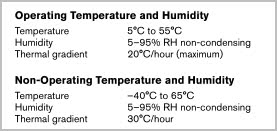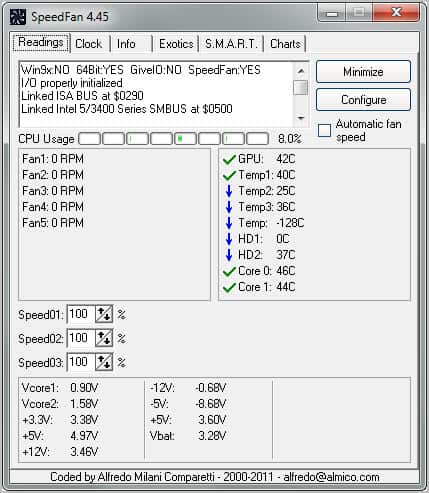Hard Drive Temperature Thresholds, What You Need To Know

Hard drives, like other electronic devices, have temperature thresholds that they need to run in. Manufacturers like Western Digital or Seagate inform their customers about those thresholds.
But how can the customers make sure that the temperature does not jump over those limits? And what are the possible consequences if a drive operates outside of the temperature threshold?
A hard drive's spec sheet usually displays information about the operating and non-operating temperatures. Most manufacturers set the operating temperature threshold at 5° Celsius to 55° Celsius. Others may have a slightly different threshold going up to 60° Celsius.
Note: Solid State Drives do not heat up which means that their temperature reading will always be 0.
A lot of things can happen if a hard drive reaches non-operating temperatures. This ranges from data corruption and data loss to crashes and even hardware failures.
Hard Drive Temperature Thresholds

While it is not likely that most computer users will ever experience that their hard drives reach critical temperatures, it can happen if they work in environments with unusually low or high temperatures. Other reasons can be bad or no cooling, or other hardware close to the hard drive that is emitting lots of heat.
How can you check a hard drive's temperature level? Most modern hard drives support a technology called SMART, which stands for Self-Monitoring, Analysis and Reporting Technology. Programs can read and display SMART data.
One of my favorite programs for the job is Speedfan, a lightweight program that reads the majority of PC sensors just fine and displays them in its interface so that you can check up on them.
Speedfan scans the hardware for sensors and displays its findings directly in the main interface.

The hard drives are listed on the right side. Normal, falling and critical temperatures are all indicated with icons which makes identification easier. You can alternatively click on the SMART tab, select one of the hard drives available and look at the SMART values for additional information. Very interesting in this regard is the temperature reading, as it lists the worst temperature the hard drive has ever reached on the system.

You can use the value to find out if the selected hard drive ever reached critical temperature levels on your computer.
If it did, you may want to start thinking about proper backup of data and replacement.
Advertisement

















Thanks Martin, For your email replay I am again a little bit further and I am going to take a look at the supplied wiki link by you.
Mine has been operating nearly non stop for the last 5 years averaging 54-58 degrees celcius. No problems whatsoever. There was a google research that was done and showed no correlation between hard disk temperatures and drive failures.
Im fact, if IRC, the harddisks operating at a cooler level were the ones that failed most often…
This is an excellent Utility for those who have name brand PCs!!
Many Mother board manufacturers, to name ASUS, include similar Utilities with their boards. AI Suite, etc provide very decent monitoring tools with alerts and tweaks.
Still, a great article and very informative!
Hoi Martin I have just email you on you news@gmail.com account concerning your article about hard drive temperature thresholds and your question after main comment/ response on your article.
Because I thought that a pictures is saying more than thousand words I just emailed you a picture from all main Speedfan readings.
In this to you emailed picture you are seeing all the readings from main Intell dual core motherboard to which I am referring to, in main earlier comment on your article concerning hard drive temperature thresholds.
Hopefully you can help me.
Thanks, have received it, you have a reply.
Ferry handy this article Martin, Maybe this make the way free for more understanding concerning the different element on the motherboard.
Like you I am a big fan of the program speedfan. When I look to the pictures here above I do not see a lot off different readings that I am getting but also different results of the readings we both getting.
Please consider that i have tried to look for answers on not only the speedfan website but also on the internet, but sadly enough I cant get any informative answers.
Or maybe when you do not want to wright a article about it please than be so kind to point me to a book or site where i can find the answers.
For instance with main intel dual core motherboard I am getting readings from speedfan like there are:
1.) Voltage regulator ( Please let me know what its fore and what’s the range that the temperatures are oke)
2.) Memory DIMM ( Please let me know what its fore and what’s the range that the temperatures are oke)
3.) PCH (What is it fore and what’s the range that the temperatures are oke)
4. CPU ( Please let me know what its fore and what’s the range that the temperatures are oke)
And than in speedfan there are also outer readings (on the bottom part) that i do not understand, please also explain them to me.
CPU VCC : 096V
3.3 V : 3,41V
5V : 5,04V
12V : 12.14V
SDRAM Vcc : 1.57v
PCH Vcc :4.07 v
3.3V Standby: 3,39 V
GPU Vddc : 1.05 v
I cannot seem to find those values that you are referring to. Can you let me know where you see them?